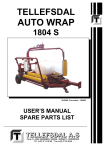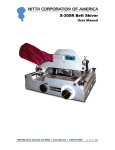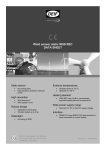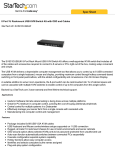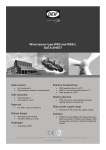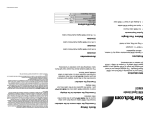Transcript
Installation Specifications Caution! Installing FAN7751U requires that you open your computer case to disconnect and reconnect wires. If you are unfamiliar with this kind of work, consider bringing your computer to your local computer store for help. CPU supported Power Adapter Cables DC Fan Size Base Material Bearing Type Speed Noise Level Air flow (Max.) Rated Voltage Intel Socket 775 Fan with Heatsink FAN7751U Introduction Thank you for purchasing a 1U Intel Socket 775 CPU Heatsink with Fan. Designed specifically for 1U rackmounted processors, this CPU Cooler supports Dual Core and high-speed Pentium 4 processors, and features an all-copper, skive fin heatsink, providing maximum heat dissipation for your hard working CPU. 1. Place the base clip backing onto the backside of the mainboard 2. Apply enough thermal paste to the top of the CPU to cover the entire top surface. 3. Remove the protective film from the CPU Cooler 4. Place the CPU Cooler over the CPU, aligning the holes on the CPU Cooler with the base clip posts. Features • Thermal transfer compound ensures quick, professional quality installation • All-copper, skive fin heatsink Before You Begin System Requirements • Socket T LGA 775 CPU • 1 available TX3 power connector • Phillips screwdriver (optional) Package Contents • Fan/heatsink (1) • Mounting bracket kit (1) • Screw-top fasteners (4) • Thermal compound (1) • Instruction Manual (1) 5. Fasten the CPU Cooler to 6. Connect the fan’s power the posts, using the screwcable to the appropriate tops provided. (Philips socket on the mainboard. screwdriver is optional) 7. Installation is complete. Socket 775 (Socket T) TX3 220-250mm 70x70x10mm All copper (CU-1100) Dual Ball Bearing 4500±10% RPM <39 dBA 30.79 CFM 12V Support, Warranty Information, and Regulatory Compliance Statement If you ever need help with your product, please contact 1-800-2651844 (In United States), 00 800 7827 8324 (in UK) or visit www.startech.com/support and access our comprehensive selection of online tools, documentation, and downloads. This product is backed by a one-year warranty. In addition, StarTech.com warrants its products against defects in materials and workmanship for the periods noted, following the initial date of purchase. During this period, the products may be returned for repair, or replacement with equivalent products at our discretion. The warranty covers parts and labor costs only. StarTech.com does not warrant its products from defects or damages arising from misuse, abuse, alteration, or normal wear and tear. Limitation of Liability: In no event shall the liability of StarTech.com Ltd. and StarTech.com USA LLP (or their officers, directors, employees or agents) for any damages (whether direct or indirect, special, punitive, incidental, consequential, or otherwise), loss of profits, loss of business, or any pecuniary loss, arising out of or related to the use of the product exceed the actual price paid for the product. Some states do not allow the exclusion or limitation of incidental or consequential damages. If such laws apply, the limitations or exclusions contained in this statement may not apply to you. FCC Compliance Statement: This equipment has been tested and found to comply with the limits for a Class B digital device, pursuant to part 15 of the FCC Rules. These limits are designed to provide reasonable protection against harmful interference in a residential installation. This equipment generates, uses and can radiate radio frequency energy and, if not installed and used in accordance with the instructions, may cause harmful interference to radio communications. However, there is no guarantee that interference will not occur in a particular installation. If this equipment does cause harmful interference to radio or television reception, which can be determined by turning the equipment off and on, the user is encouraged to try to correct the interference by one or more of the following measures: • Reorient or relocate the receiving antenna. • Increase the separation between the equipment and receiver. • Connect the equipment into an outlet on a circuit different from that to which the receiver is connected. • Consult the dealer or an experienced radio/TV technician for help. Revised: 2 November 2006 (A)

